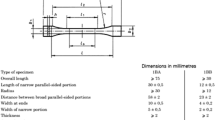Abstract
The objective of this study is to elucidate the relation between the results of ball drop tests and the residual stress distribution of an injection-compression molded part. To improve the ball drop property, a high impact material and a robust manufacturing process were employed. For the application to the transparent plastic window, it is of great importance to increase the impact strength of plastic products. Thin-walled plates were molded with use of rubber nanoparticles embedded poly(methyl methacrylate) (PMMA). Different compression gaps were considered during injection-compression molding (ICM) to adjust the residual stress distribution developed in the specimens. The ball drop tests were carried out to evaluate the impact strength of the prepared samples. In addition, the ICM was numerically simulated to predict the residual stress distribution in the parts.
Similar content being viewed by others
References
Aid, S., A. Eddhahak, Z. Ortega, D. Froelich, and A. Tcharkhtchi, 2017, Experimental study of the miscibility of ABS/PC polymer blends and investigation of the processing effect, J. Appl. Polym. Sci. 134, 44975.
Baek, S.J., S.Y. Kim, S.H. Lee, J.R. Youn, and S.H. Lee, 2008, Effect of processing conditions on warpage of film insert molded parts, Fiber. Polym. 9, 747–754.
Chen, H.L., S.C. Chen, W.H. Liao, R.D. Chien, and Y.T. Lin, 2013, Effects of insert film on asymmetric mold temperature and associated part warpage during in-mold decoration injection molding of PP parts, Int. Commun. Heat and Mass Trans. 41, 34–40.
Grijpma, D.W., A.J. Nijenhuis, P.G.T. van Wijk and A.J. Pennings, 1992, High impact strength as-polymerized PLLA, Polym. Bull. 29, 571–578.
Hong, S. J. Hwang, J. and K. Yoon, 2015, Comparison of injection molding and injection/compression molding for the replication of microstructure, Korea-Aust. Rheol. J. 27, 309–317.
Jeong, S., C. Cho, H. Kang, K.H. Kim, Y. Yuk, J.Y. Park, B.J. Kim, and J.Y. Lee, 2015, Nanoimprinting-induced nanomorphological transition in polymer solar cells: Enhanced electrical and optical performance, ACS Nano 9, 2773–2782.
Kwon, Y.I. and Y.S. Song, 2018, Application of injection-com-pression molding to thin-walled polymeric parts, Korea-Aust. Rheol. J. 30, 161–167.
Lee, D.H., H.J. Oh, S.J. Bai, and Y.S. Song, 2014, Photosynthetic solar cell using nanostructured proton exchange membrane for microbial biofilm prevention, ACS Nano 8, 6458–6465.
Oh, H.J., D.J. Lee, C.G. Lee, K.Y. Jo, D.H. Lee, Y.S. Song, and J.R. Youn, 2013, Warpage analysis of a micro-molded parts prepared with liquid crystalline polymer based composites, Compos. Pt. A-Appl. Sci. Manuf. 53, 34–45.
Oh, H.J., J.H. Park, S.J. Lee, B.I. Kim, Y.S. Song, and J.R. Youn, 2011, Sustainable fabrication of micro-structured lab-on-achip, Lab Chip 11, 3999–4005.
Oh, H.J. and Y.S. Song, 2015, Precise nanoinjection molding through local film heating system, RSC Adv. 5, 99797–99805.
Oh, H.J. and Y.S. Song, 2017, Surface strengthening of injection molded parts by applying a thermal insulation film, RSC Adv. 7, 14302–14308.
Ramaraj, B., 2007, Mechanical and thermal properties of polypropylene/sugarcane Bagasse composites, J. Appl. Polym. Sci. 103, 3827–3832.
Williams, J.A., 1999, Analytical models of scratch hardness, Tribol. Int. 29, 675–694.
Wong, M., G.T. Lim, A. Moyse, J.N. Reddy, and H.-J. Sue, 2004, A new test methodology for evaluating scratch resistance of polymers, Wear 256, 1214–1227.
Yeh, C.-L., Y.S. Lai, H.C. Chang, and T.H. Chen, 2007, Empirical correlation between package-level ball impact test and board-level drop reliability, Microelectron. Reliab. 47, 1127–1134.
Yu, L., C.G. Koh, L.J. Lee, K.W. Koelling, and M.J. Madou, 2002, Experimental investigation and numerical simulation of injection molding with micro-features, Polym. Eng. Sci. 42, 871–888.
Author information
Authors and Affiliations
Corresponding author
Rights and permissions
About this article
Cite this article
Oh, H.J., Song, Y.S. Enhanced impact strength of injection-compression molded parts by controlling residual stress distribution. Korea-Aust. Rheol. J. 31, 35–39 (2019). https://doi.org/10.1007/s13367-019-0004-7
Received:
Revised:
Accepted:
Published:
Issue Date:
DOI: https://doi.org/10.1007/s13367-019-0004-7




